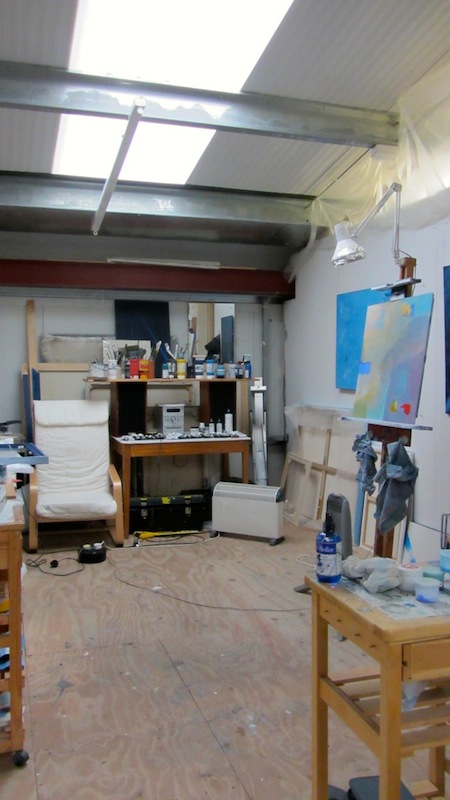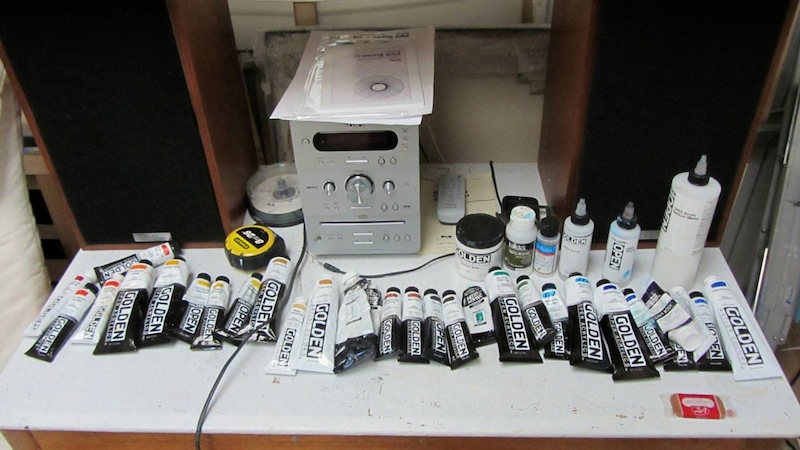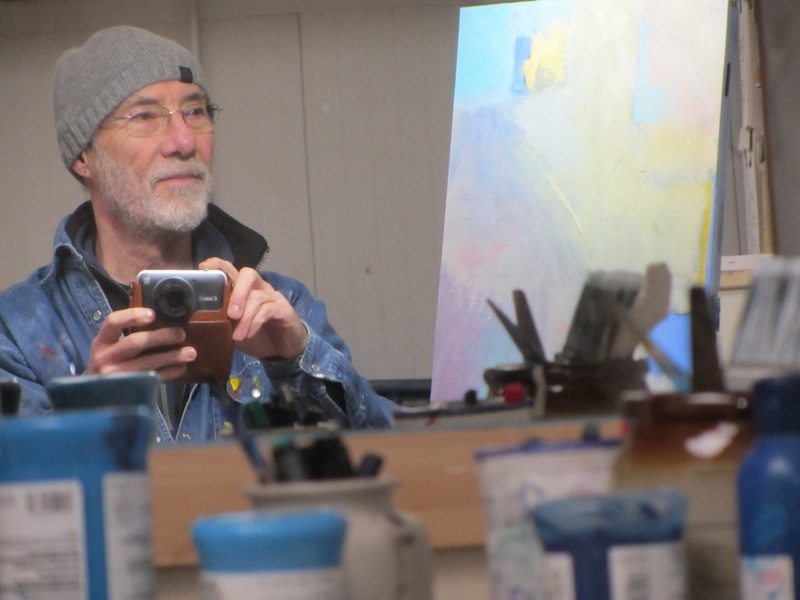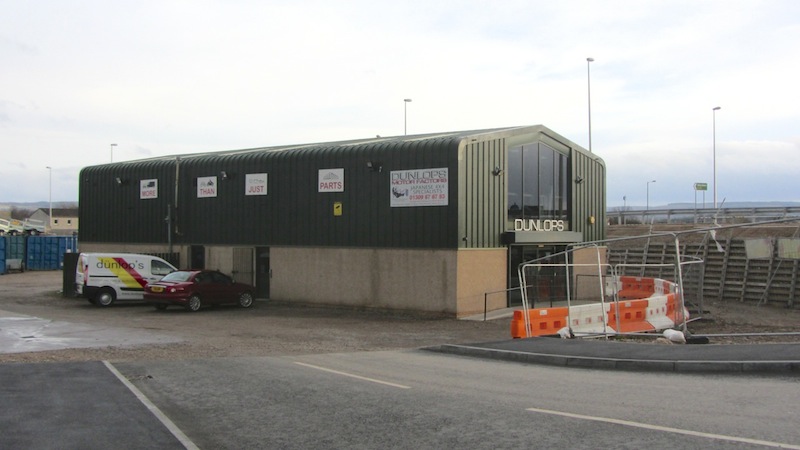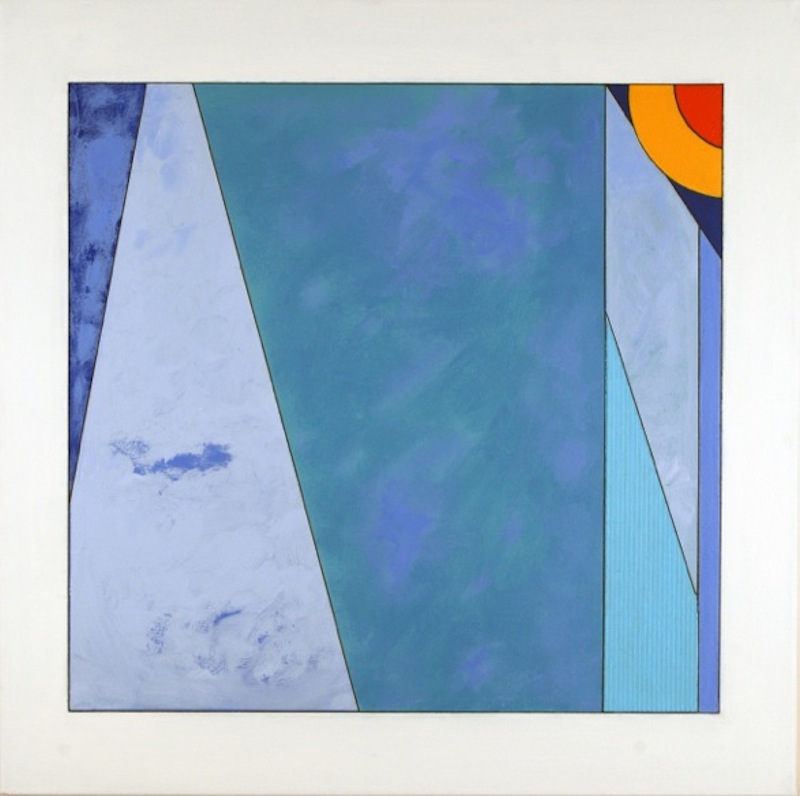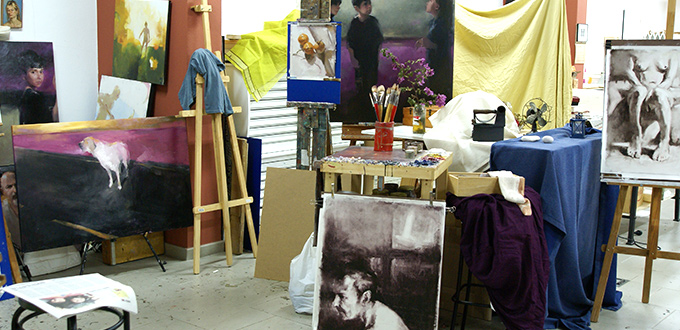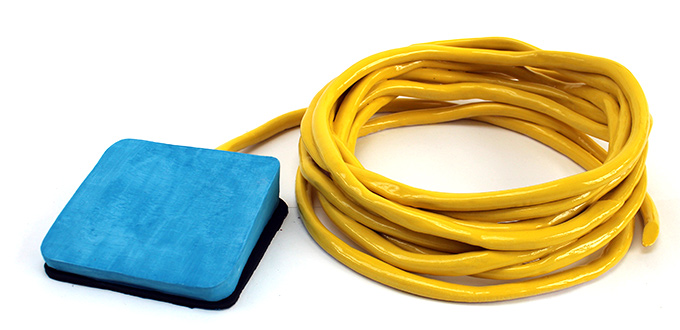To imagine my studio, you first have to bring yourself to Northern Scotland, which, in case you don’t know, is the top half of the United Kingdom, above England. We are really stuck out in the North Atlantic, subject to westerly winds, long days in summertime, and of course long nights in winter. Being so far north and on the edge of the ocean gives us beautiful clean air and crystal-clear light. Painter’s light, I call it.
My studio is on the outskirts of the town of Forres (which gets a mention on the first page of Shakespeare’s Macbeth), in the ancient county of Moray. The building is in an Industrial Zone, and is owned by an auto parts business. That business occupies the ground floor, and around the side there is a nondescript metal door that leads upstairs to the Side Door Studio. For me, it’s the equivalent of Platform 9 3/4 in Harry Potter. It seems like a magical transformation going from the outside world into a place where artists work.
There are seven of us sharing the open-plan top floor. I suppose it looks a bit like a New York loft on the inside. We have divided the floor area into what we call “full spaces” and “half spaces,” and we pay rental to the business downstairs based on this. We’re lucky; when he was young, the shop-owner graduated from art school and although he never followed through on it, he still has an interest in the arts. In fact, he and his wife bought two of my paintings! They are both muy sympático and are good landlords.
I’ve been here about two years now, and feel really supported and “safe” and able to make a mess, which is very important. My half-space (painters don’t need as much room as installation artists, I find) has good light from a north-facing skylight. When I arrived, I put in a long kitchen work-top on a trestle, painted the walls white, acquired a comfortable chair, installed my ancient hi-fi, and settled in really quickly.
My last studio was nearer the center of town, and just across the street from my apartment, which is too small for art. I had been looking for a bigger studio and put the word out on Facebook to the local artists’ community. Before long I was in the company of some new and some old friends. All of us are art school graduates, from Bachelor’s or Master’s level. I think the discipline and work ethic you learn at art school is vital to being successful as an artist. Although, of course, it is possible to achieve that state without going to college—it depends on the individual. The one thing I’ve noticed about all of my artist friends is that it is a “calling,” and something we must do rather than a career path.
The best thing about sharing in the Side Door Studio is the tacit understanding that we are all on the same mission—to express ourselves. So we support and encourage each other, but we also know when to just give each other some space. The worst thing about this particular space is that it is not zoned for public access, so we can’t hold exhibitions or anything involving the public at large, because of local government health and safety rules. But hey, it’s cheap.
I’m a process-led painter, and usually have no idea when I start a new canvas what it will lead to. I like to use paint expressively, which is not a unique standpoint these days. However I do prefer some control over my process, so that I’m not just mark-making for the sake of it. That’s where the self-discipline and acquired skills of observational painting you do when you are at college come in handy. Learning to control, and learning to let go, are equally important. I think there is nothing more engrossing than working towards getting a likeness in life drawing, but you have to remember that it’s not always about the final result. Its about how to observe and how to see, and how to quickly turn that into two dimensions. That’s the part that helps you later if you are an expressive painter.
Generally I work on several pieces at once, in bursts of three or four hours, maybe four or five days a week. I listen to music while I work, through noise-canceling earbuds or through my large speakers if no-one else is present, and often give my paintings names from whatever I’m listening to during the process. Names are kind of arbitrary in this style of painting, but I prefer this to untitled numbers.
My favorite painters and hence my influences are mostly American, but usually those with a more European attitude to color, such as Richard Diebenkorn and Milton Avery. Recently I’ve been exploring in a kind of Suprematist way in planes of color. I have always believed in the power of art to spiritually transform the viewer (and the artist) using only color and non-representational forms. If I look back at all of my work, I see that I’ve been trying to do this all along, without realizing. There is a thread running through it, a thread made of color and of form without meaning, and a journey of no fixed destination.
In the art world we have become used to the idea that new movements are a necessary part of “progress,” whatever that is. I think the time has come for us to realize that, in painting at least, it has all been done before, and each movement is as valid as any other. So I find myself in a Fauvist mood one week, and maybe in a Minimalist mood another week, and so what? I’ll never completely inhabit Matisse’s shoes, and I don’t want to be mistaken for Diebenkorn, but sometimes the logic of the work in front of you takes you down a certain road, and you have to explore that road. Along the way you find you have made the same decisions as your predecessor, and yet have arrived at a slightly different place.
For artistic inspiration I like to visit the seashore. We are five miles from a village called Findhorn, which has a beautiful bay, and a sandy beach about five miles long. My partner and I walk the beach at least twice a week, noting subtle shifts in color and mood. This works wonders for the brain, this opening to vast horizons, and feeds the soul. There are no museums or art galleries around here in the North. Sometimes, if there is a major exhibition on, I take the three-hour train journey to Edinburgh or my home city of Glasgow. Once, I went to London by overnight sleeper train, visited the major retrospective of Rothko’s work at the Tate Modern, walked around it for hours until they threw me out (you are only supposed to walk around once) and then caught the overnight sleeper back home, with my dreams full of color. As Mark Rothko once said, “A painting is not a picture of an experience; it is an experience.”
Brian Crawford Young’s website is www.briancrawfordyoung.co.uk.
Favorite paints and hi-fi
A recent selfie
Auto Store with studios above
The Side Door Studio
Brian Crawford Young, Red on Cyan, 2011. Acrylic on canvas, 100 x 120 cm.
Brian Crawford Young, Frisson, 2013. Acrylic on canvas, 67 x 67 cm.
Brian Crawford Young, Locomotion, 2011. Oil on canvas, 76 x 250 cm.
Brian Crawford Young, Remembering Marinot, 2014. Acrylic and cardboard on canvas, 58.5 x 56 cm.
Brian Crawford Young, Elegiac Melodies, 2013. Acrylic on canvas, 72 x 66 cm.
Brian Crawford Young, Nulla in Mundo, 2014. Acrylic and cardboard on canvas, 58.5 x 56 cm.



